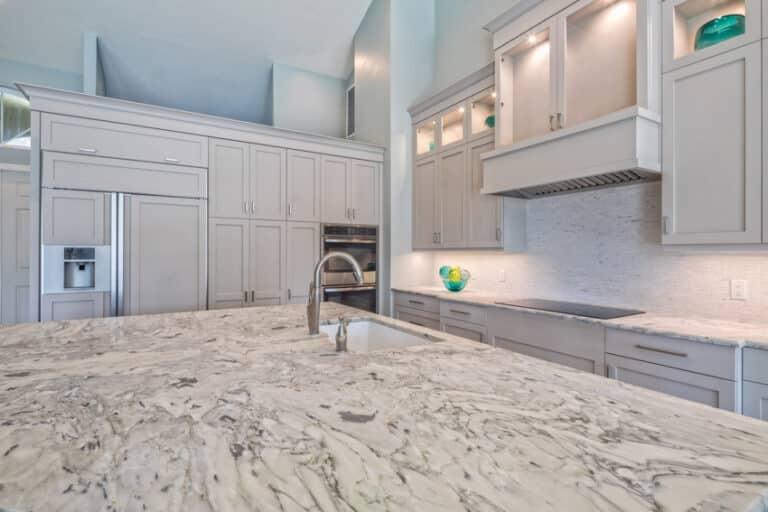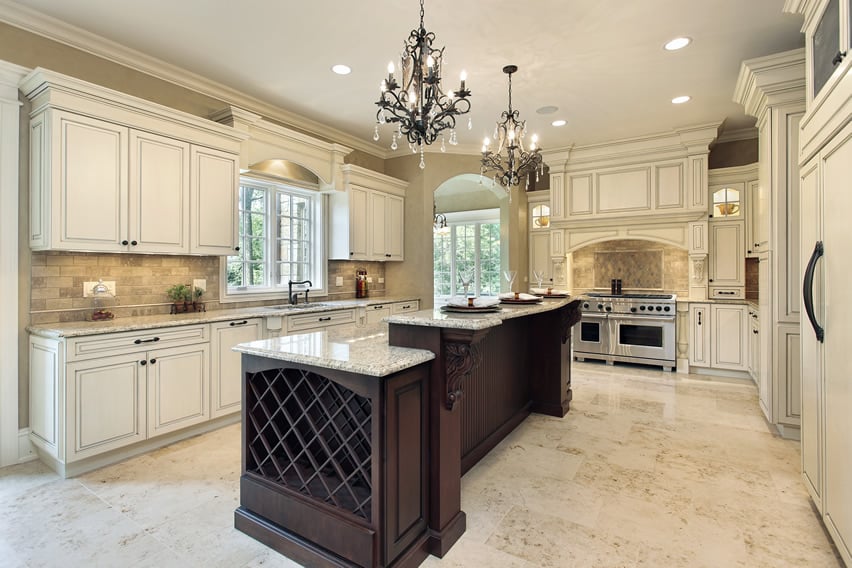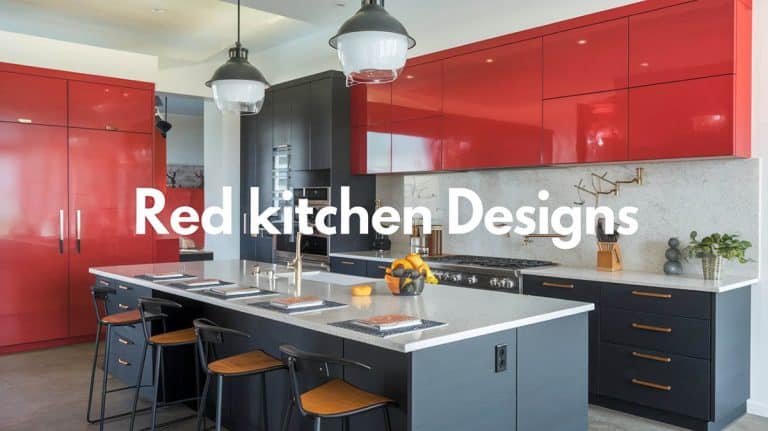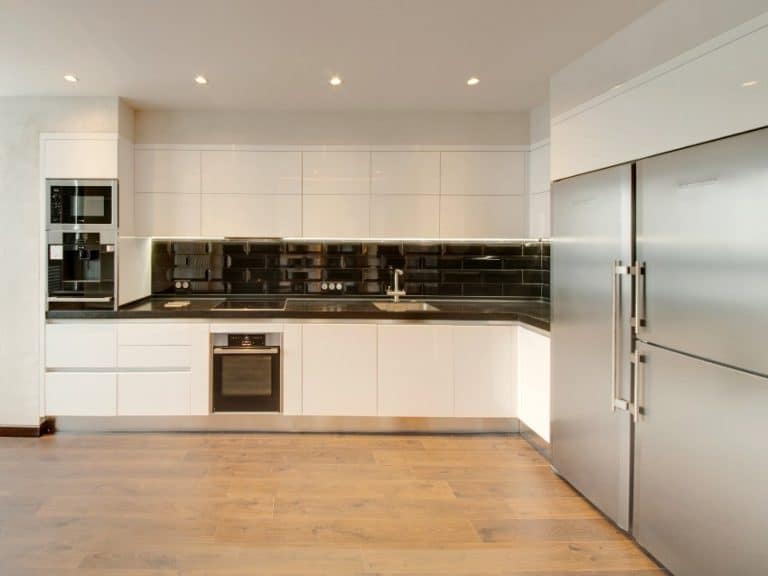Lights Above Kitchen Cabinets (Types & Options)
Lighting above cabinets is a terrific way to illuminate your kitchen cabinets while enhancing their style. It also aids in the addition of necessary light for near-cabinet tasks and awareness inside cabinets, as well as the creation of attractive, dramatic lighting with or without the use of ceiling lighting fixtures.

These over-cabinet lights come in various styles and colors and are especially ideal for illuminating areas above cabinets. Lighting colors and finishes vary, making selecting the proper light for the job simple, whether highlighting display items or integrating lights into crannies and nooks.
Over-cabinet lights make it simple to generate a radiant mood in your kitchen. In this article, we will go over the different types of lighting fixtures that you can use above your kitchen cabinets.
Types Of Lighting For Above Cabinets
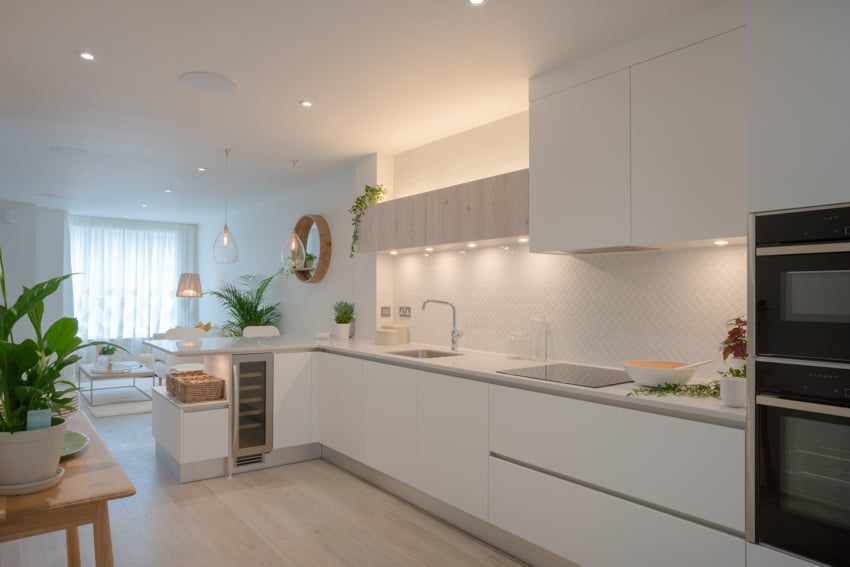
The lights above kitchen cabinets are prevalent in contemporary designs or wherever cabinets, shelves, or drawers might be improved, and they offer a professional touch.
These ceiling lights sweep away the dark shadows, creating an inviting environment and bringing to life a typically overlooked spot. Various light options are available for above-cabinet lighting to accommodate various designs and preferences. Below are some of the more popular options.
LED Lights
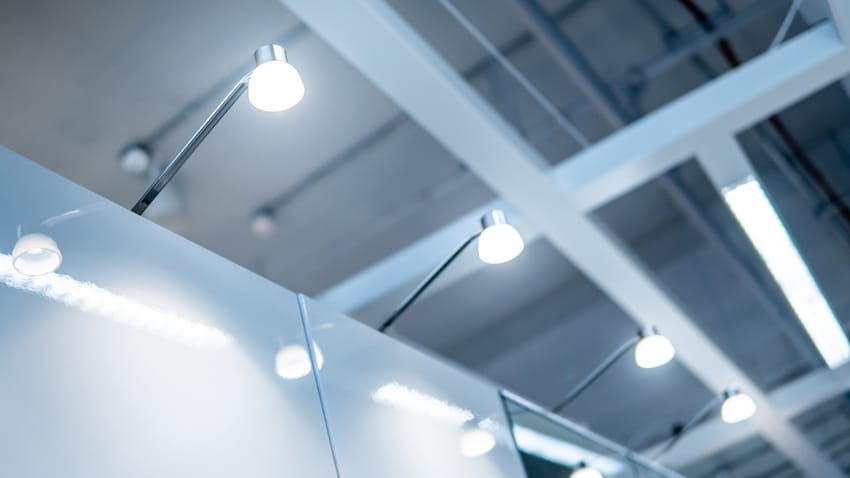
Skillful designers and homeowners worldwide recognize that installing high-quality indirect lighting can bring practically any kitchen to life. Above-cabinet LED lighting is a widely known way to accomplish this.
It is just an easy do-it-yourself solution that will significantly enhance the visual attractiveness of any kitchen. LED lights utilize 75% less energy and last 25 times longer than typical incandescent lights because of its upgraded technology.
LED light fixtures above kitchen cabinets emit a large, pleasant glow that is more advisable to use than traditional overhead lighting systems and bulbs. Small, adaptable LED lights can be discreetly fitted to the top of any cabinet to offer a lovely diffused light source with no exposed wires or unsightly parts.
It is quite an ideal way to brighten your kitchen, especially the space around your cabinets. Furthermore, the above-cabinet LED lights are available in a variety of designs, shades, and white hues to fit any layout.
The vast majority of them are also dimmable, providing you with complete control over setting the ideal ambiance. LED lights can last up to 50,000 hours and will not harm cabinets because they remain cool whenever you touch them.
It is obscured above the cabinets and provides over a decade of energy-efficient, attractive, and secure indirect lighting. Adding above-cabinet LED strip lights is another great way to add vibrancy to your kitchen or generate functional task lights.
To meet every purpose, single-color, color-changing RGB, and configurable white LED strip lights are offered in weatherproof, shockproof, and indoor forms. You may use a remote, tablet, or computer to operate them, and their adhesive backings make installation easier.
String Lights

String lights are the well-known garland luminaire style of light. Transparent bulbs are suspended on a uniformly spaced cable. They can also brighten the area beneath them. You may even make it more appealing by hanging lights or decorations or adorning your cabinets’ entire arrangement.
If your kitchen cabinets have a space between the cabinet’s uppermost portion and the ceiling, string lights fitted in the recessed spot would be ideal. It can offer a striking element to the lighting design in your kitchen. String lights, which are made up of a continuous strand of tightly linked fixtures, provide continuous accent lighting with no overly bright spots or gloomy corners.
The best part is that if your layout already includes an outlet built above the kitchen cabinets, then all you need to do is plug in the subtle light and scatter it out. String lights above the cabinets will set the tone and atmosphere in the kitchen.
The illumination above-cabinet string lights typically produce is white and warm, sufficient to illuminate even huge cabinets appropriately. It is normally carefully utilized and placed, and the brightness and concentration of the string lights can be adjusted.
Cove Lighting

Cove ceiling lighting, a sort of uplighting that sends illumination to the ceiling surface from a cove solely on a single or even more kitchen corners to give general diffuse illumination, is among the most popular kitchen illumination strategies. This type of lighting is often installed on or built into a wall but can also be installed above a cabinet.
Cove lights are among the greatest ways to illuminate specific areas of your cabinets softly. Cove lights above cabinets can effectively highlight the kitchen layout for visible reference points.
Moreover, cove lighting may be useful in bigger kitchens to emphasize certain items near cabinets. Cove lights on top of the cabinets can accentuate cookware and other goods on exhibit in small kitchen layout dimensions, and well-placed cove lights can make the kitchen feel more spacious.
A well-placed cove light between the ceiling and the upper cabinet is an excellent choice. Generally, thin string lighting is concealed between the ceiling and the cabinetry’s topmost surface. You will appreciate how the lights emphasize the sleek modern design and the sensation of openness of the area, making the full-height cabinets appear less overwhelming.
Cabinet Interior Lighting
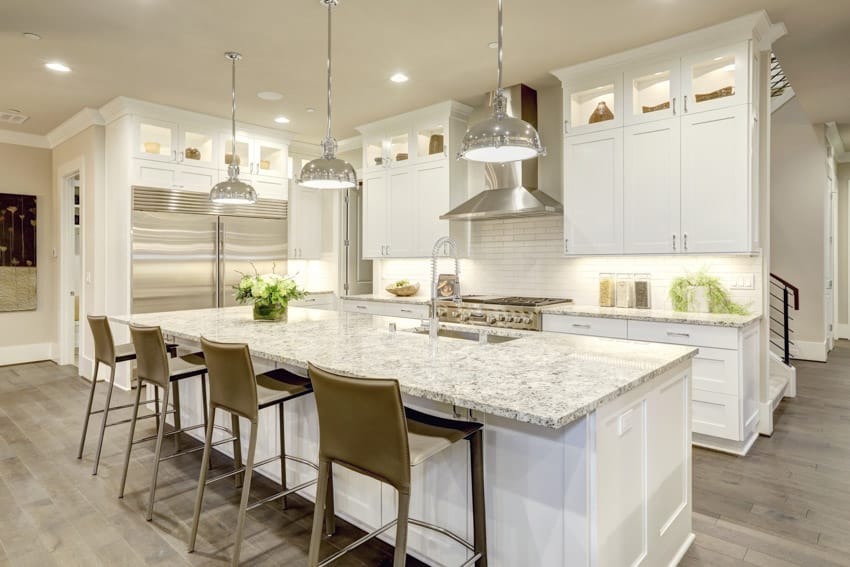
Cabinet interior light fixtures elevate the look of your kitchen. Interior lights emphasize goods on cabinet shelving, thereby providing subtle mood lighting for your kitchen in glass-fronted or open cabinets. This lighting is ideal for displaying decorative items in your cabinets. A spherical light from above or a straight light hidden below the face frame is usually applied.
Moreover, motion-detecting lights are quite useful in cabinets with solid doors and can even be employed in deeper-base cabinets to assist you in finding items such as a pot cover that has made its way to the rear of the cabinet.
Interior cabinet lighting does not have to be restricted to rectangular fixtures or large pucks. Technology has advanced to the point where thin, unobtrusive strips can be placed without any electrical expertise.
Kitchen cabinet interior lighting, unlike under-cabinet lights, is not intended to be the predominant source of illumination for conventional activities like preparing meals.
In many situations, particularly with glass kitchen cabinet doors, the lights that are put within a cabinet are employed for aesthetic purposes rather than practicality, primarily illuminating the cabinet’s contents slightly when the central kitchen lights are turned off.
This style of lighting is similar to cove lights in that it offers a touch of an elegant and premium vibe to kitchens without adding considerable illumination.
Whenever you open the cabinet door, a separate sort of cabinet interior light highlights the items of the cabinet, similar to certain stick-on, battery-powered lighting fixtures used in bedroom closets that do not include their separate hard-wired light source.
Furthermore, a small motion-sensing interior light is also an excellent choice for deep cabinets or pantries that are not adequately lit by overhead kitchen lights. Several are fairly vivid and must be placed for maximum effectiveness while opening and closing drawers and doors or relocating the cabinet’s items.
Track Lighting
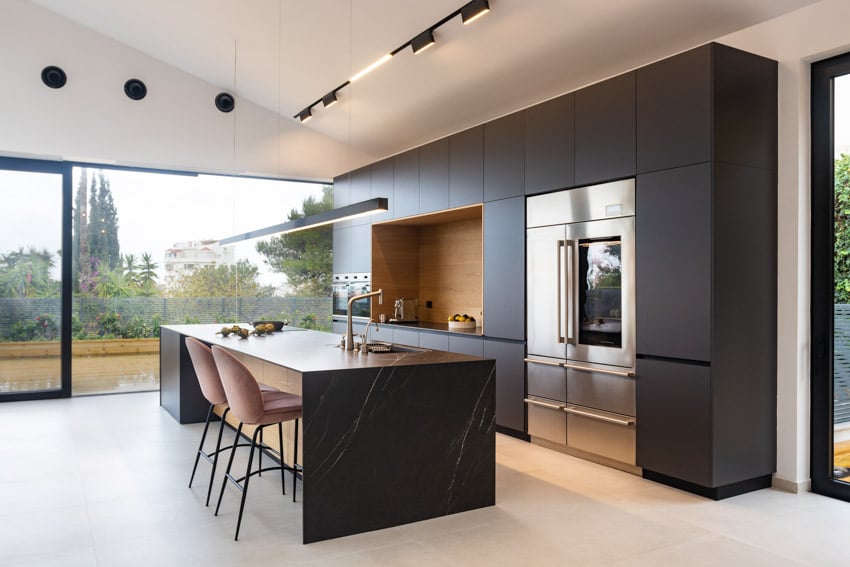
Kitchen track lighting is adaptable, affordable, and simple to reposition. It delivers task lighting precisely wherever you require it. Track lights are, therefore, suitable for cabinets.
It appears to be the lighting option that can do nearly everything, from sleek, curved tracks with high-intensity halogen lights that flow around the kitchen to plain tracks with LEDs that brighten the cabinets.
To draw attention to track lights in your kitchen, you can choose a strong contrast in color from your cabinets. A matte black track light arrangement balances almost any kitchen style, offering a visual interest as well as practical, customizable light fixtures.
Best Lighting For Above Cabinets
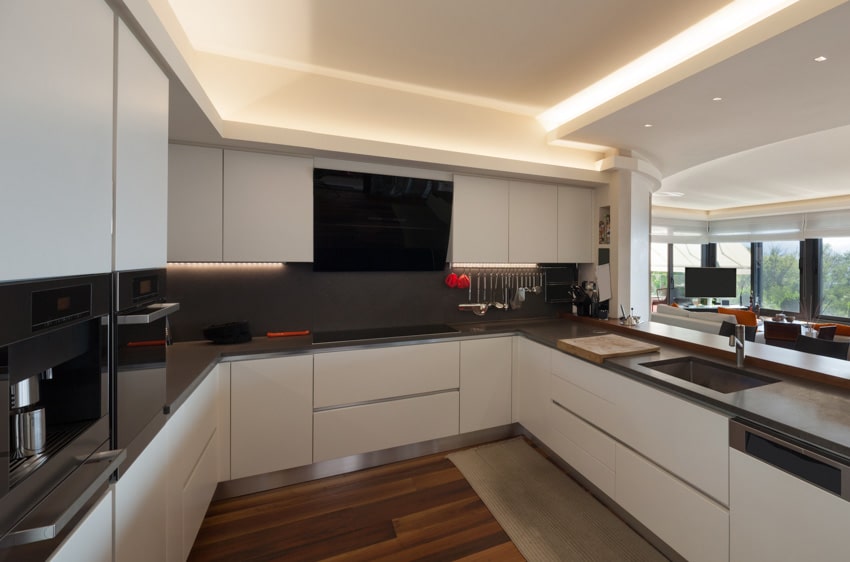
LED types of lighting fixtures are the best option for the above kitchen cabinets. They save energy, feature a long life expectancy, and do not get hot when being used. LED lights may also be dimmed, making them excellent if your cabinet lights are also a part of the room’s accent lighting.
They are also available in a multitude of colors in addition to white, which can end up making the lighting layout of the space more fascinating when utilized for glass-fronted cabinets.
In comparison to any alternative above-cabinet lighting solutions, above-cabinet LED lights employ the same method as under cabinet lighting and will certainly last much longer, use less energy, be easier to use, and look absolutely stunning.
How To Add Lighting Above Kitchen Cabinets
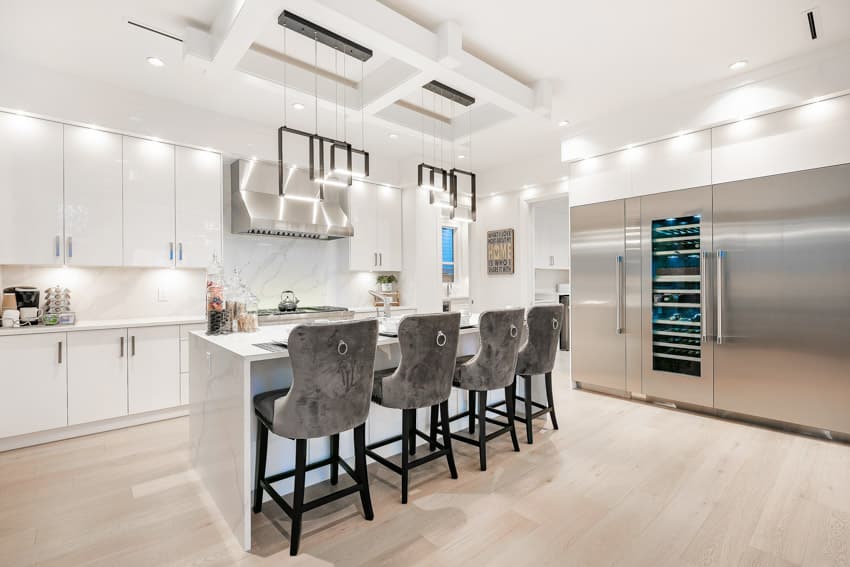
First, you must determine what supplies and how many you will need before you begin installing the above cabinet lighting in your kitchen. Develop your customized installation plan.
If you think it is helpful, draw things clearly or create a list divided by area. Examine the number of cabinet junctions as well as the number of instances you will connect from one lighting section to another or to a piece of extra wiring.
It’s also helpful to measure each section carefully so you have enough electrical cords. This way, you can reach all of the areas you want illuminated or connected to the planned fixtures.
The easiest objects to remember are the bigger materials, including power cords, controllers, and power supply units. Nevertheless, it is indeed easy to ignore the little things. Small objects can be anything from cable ties mounting units for holding wire or connections to double-sided adhesive sheets for controllers and terminal boards.
Hence, you have to plan how you will complete each step of the procedure, from connecting to an electrical outlet and wiring your power source to linking light fixtures to controllers and one another.
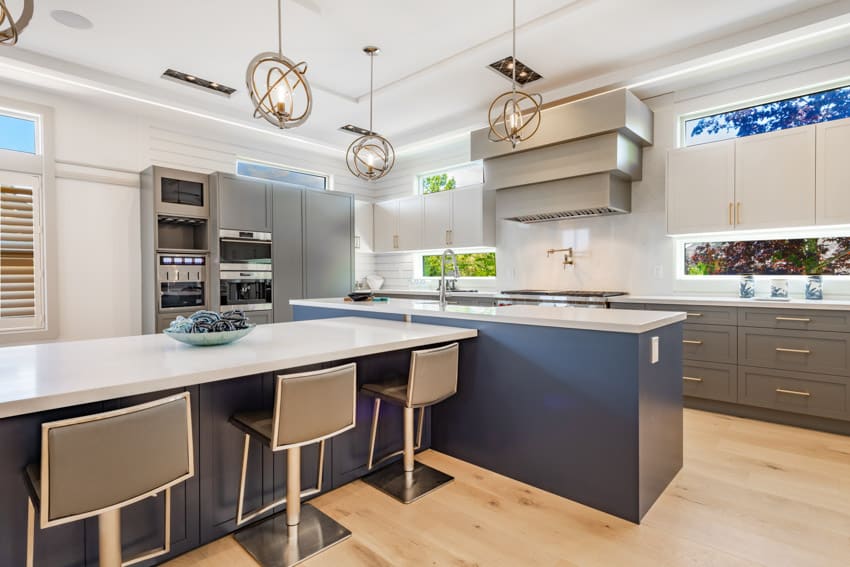
You also have to plan how you will be navigating around obstructions like kitchen windows or cooktops to decide what you will need. Once you have considered these things, you may not start installing the lighting above your kitchen cabinets.
Here are the above cabinet light installation steps you can follow:
Step 1: Create an opening on the top of your cabinets, just above the place where your power source resides.
Step 2: Start connecting your extra controller to the power source using a two-conductor power supply unit. Connect the power line to the controller located above your cabinetry.
The power wire should be threaded into your cabinet from the top and inserted into the terminals on your extra controller where the power source lines are placed.
Including a secondary controller for your above-cabinet lighting panels or strips allows you to control them independently. However, you can use the zone controls to operate all sets of lights with a single controller.
Step 3: Connect the controller to the top of your cabinet with a double-sided adhesive sheet if appropriate.
Step 4: Connect the pigtail connector cables to the suitable areas on the controller, then secure them. Attach the connector’s opposite end to the base of your initial light panel or strip.
Step 5: Cut along the indicated cut line, reaching near the end of the cabinet when allowed, but leave room for an additional connecting jumper. Stretch the strip to the end of the cabinet.
However, the strips might be visible from various angles throughout the room. So, you have to lay out your lighting strips and observe them from a distance to make sure you prefer how they will look when they meet intersections.
Step 6: Remove the adhesive backing from the strip and fasten the connecting jumper.
Step 7: Fasten the other end of the connecting jumper onto the next length of the strip and attach the strip to your cabinet.
Step 8: Duplicate this procedure until you reach the corner cabinet. Gently bend the lighting strip to a 90-degree angle and keep installing it until you approach the end of your cabinets.
Talking about the lighting fixtures, it would be your choice what type of lighting you would like to install above your kitchen cabinets. But as aforementioned, LED lights are the most highly recommended option.
See more related content in our article about low ceiling kitchen lighting on this page.

